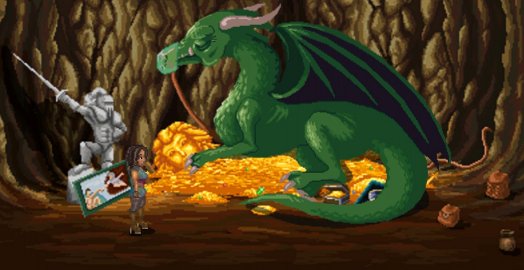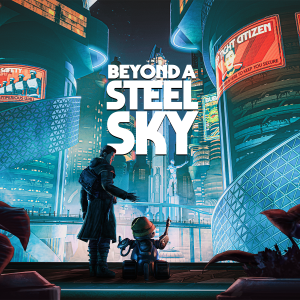Review for Monkeys & Dragons

Monkeys & Dragons might be the perfect title for the game it’s attached to, though probably not in a way the developer intended. To be clear, there’s exactly one monkey and one dragon in this game, and neither features in more than a single puzzle. So from a story and design standpoint, Monkeys & Dragons fits this game about as well as Parrots & Yaks would The Secret of Monkey Island. And that, paradoxically, is why it’s perfect. The decision to bestow this particular title on a game that is in no real way about monkeys or dragons neatly encapsulates the unfathomable bizarro-logic that animates just about every subsequent design choice of this retro-styled point-and-click adventure. Its steadfast refusal to ask whether what it’s doing makes any kind of sense is one of only two arenas where the game shows something like consistency, and as to the second—did you understand that Monkey Island reference a few sentences ago? Did you like it? Would you pay money to read a review where I paused every few lines to make it again? If not, Monkeys & Dragons likely isn’t for you. (If you would, please reach out. I’ll send my PayPal info and a Word document.)
The story begins as Lana and her husband Jack arrive on a tropical island for their honeymoon. As soon as they leave the boat, a mischievous sorcerer appears and identifies himself as Jack’s ex-boyfriend, out for revenge, and with that he magically whisks his former beau away and locks him in a tower. Refusing to let this stand, Lana resolves to become an adventurer so that she can storm the sorcerer’s fortress and rescue her man.
That’s about all the plot Monkeys & Dragons has. As Lana, you’ll go to the local adventurers’ guildhall and ask the senior adventurers how to join their ranks, and naturally they’ll explain the obligatory three trials you’ll have to complete. The rest of the game follows Lana as she tackles these tasks—plus two more once she’s joined the guild, just to gain experience—and then goes to save Jack. None of the trials have anything to do with Lana, her husband, or the sorcerer; they’re just busywork that will take you around the island, and only one character you meet along the way winds up having any impact on the actual quest. Depending on how good you are at Sudoku (we’ll get there), it should take you between four to six hours to complete.
The island’s inhabitants are mostly just puzzle-delivery mechanisms without much personality, and dialogues tend to be short and purely functional. You’ll meet someone, they’ll tell you what they need or what they can do for you, and you’ll set about making that happen. Plenty of potentially interesting characters—like the titular dragon and a farmer beset by carnivorous worms—show up for one scene, say a few lines, and then vanish once they’re no longer needed. Jack and the sorcerer, ostensibly the main character’s love interest and antagonist, have maybe six lines between them; you never get a sense of their past together or of Lana and Jack’s relationship. Lana herself comes closest to having some kind of characterization, even if it’s just the adventure-standard “protagonist with a snarky wit and a tendency to break the fourth wall.”
LucasArts may have popularized the three-trials structure as a first act device—at least in adventure gaming circles—but it became ubiquitous as a design formula for its own reasons: it’s simple, it’s versatile, and it incentivizes exploring the game world by providing multiple goals early on. It’s so widely used at this point that it only becomes a Monkey Island reference if the developers insist on it, and here they do—very, very forcefully. In fact, Monkeys & Dragons cribs so liberally from Monkey Island that it’s maybe one breath mint away from having to label itself a fan-game. Like Guybrush Threepwood, you receive your tasks from three elders of the society you hope to join, whom you’ll find sitting side by side at a long table by a fireplace. They tell you to prove yourself in the arenas of combat, thievery and hunting and, as in The Secret of Monkey Island’s three trials, you’ll then have to defeat a female weapons expert outside her forest cabin (the “Spearmaster” here, as opposed to the MI games’ Swordmaster), recover a unique T-shirt, and acquire a shovel for a task that requires digging in the woods. You’ll receive advice and guidance from the proprietor of a local voodoo shop, and you’ll deal with a fast-talking, arm-flailing used-goods salesman (named Dan rather than Stan). You’ll even lay a trap using poisonous yellow flower petals.
It’s all done self-consciously—the game never pretends that these are anything but allusions to another game, signposting each with winking dialogue—but there’s no interesting twist or novel commentary on its predecessor. “Remember Monkey Island?” the game seems to be saying, before lamely finishing, “Well, that’s it.” It’s not impossible to build a solid title using classic references as a foundation—see the Ben and Dan games, for example—but it is difficult. Even in an otherwise-strong title, it runs the risk of diluting or distracting from the game’s own vision, while in a weaker one it just serves to remind me of better games that I could play instead. It’s hard to find a fun and original way to repeatedly nod to something that everybody recognizes; more often than not, and nowhere more than in Monkeys & Dragons, it comes across like repeating a joke after the room has finished laughing.
These sins would be forgivable in an adventure with engaging gameplay or well-designed puzzles. Monkeys & Dragons isn’t that game. The solutions to the (usually inventory-based) puzzles rarely make much sense; I solved several by dumb luck, as often the only strategy I could muster was to use my items on everything in sight. The game world is small enough that I never had to spend too much time searching—a helpful map feature lets you travel instantly from place to place—but it was still tedious. Oftentimes I’d walk around knowing what my goal was but without any of the information necessary to approach it. I eventually realized the game expected me to go to the voodoo shop and ask the proprietor for advice on every single task I received, though it never gives you any particular reason why he would know these things or why you might think to check with him. My hunch is that the developer figured Monkey Island would have conditioned players to just expect wisdom in voodoo stores and that no extra prodding would be necessary.
There’s a bit more puzzle variety as you approach the end of the game, when you’ll find several doors locked with slider puzzles, with instructions helpfully provided alongside. These are fine, if unremarkable, until you get to a lock that’s simply...Sudoku. There’s nothing unique or special about it, no twist or innovation that makes it “a Monkeys & Dragons Sudoku.” There’s not even any themed art. It’s just a bog-standard, taken-from-a-puzzle-generator Sudoku grid, plopped into the game entirely unaltered. “Solve the Sudoku puzzle,” the instructions read, and that’s the extent of it. You might or might not have been in a Sudoku mood when you chose to play a comic fantasy adventure; the game doesn’t care. “We couldn’t think of what to put here,” it seems to say, “so play this other game for a while and check back when you’re done.”
If that had been the first and only design choice that felt rushed or like a placeholder, it probably would have bothered me more, but so many parts of Monkeys & Dragons feel straight-up unfinished that I started to take it in stride. Take the dialogue system: the game doesn’t seem to keep track of whether or not you’ve spoken to a character before, so that each time you talk to someone it’s treated like the first time and the conversation plays out identically. It only changes once you’ve advanced a questline, at which point the new set of dialogue will repeat endlessly. Clicking anywhere on the screen during a conversation causes Lana to walk away mid-sentence, so that you have to start the whole thing over if you hadn’t heard everything you needed yet.
There’s also the inventory system, which lets you use items together but has trouble discriminating between a combination that works and one that doesn’t. It’s possible to use a pair of items together to create a new one—“Use rocks with bucket” might produce a bucket of rocks, for instance—but you can also use two items simultaneously, so that using your bucket with a torch might result in an object line reading “Use bucket and torch on ____.” Using the bucket on itself, though, will result in the nonsensical “Use bucket and bucket on ____.” This is especially a problem because the stripped-down SCUMM-style verb interface—consisting solely of EXAMINE, TALK, and USE—will sometimes get stuck, so that you can’t switch from one verb to another without clicking the button three or four times; using things on themselves when I meant to simply examine them was a regular occurrence. On top of that, pathfinding and animation issues sometimes allow Lana to walk somewhere she shouldn’t be able to, and there’s at least one puzzle where using an item on one side of a large hotspot produces a “That doesn’t work” message, while using it on the other produces results.
Some features are just strange, like the “CUTSCENE” caption that floats at the top of the screen during such sequences, as if players couldn’t figure it out themselves. There’s also the way the game doesn’t end so much as it just stops; the final puzzle consists entirely of walking around the island until you stumble on a pair of new characters who literally offer to solve it for you. Doing this leads to a five-second cutscene where Lana proclaims her adventure to be at an end, after which you’re allowed to keep playing until you realize there’s nothing left to do. There are no final credits or text telling you that you’ve won; it’s left up to you to figure out that, one way or another, the game is over.
I’d be lying if I said Monkeys & Dragons did nothing right. The pixel art is well-composed, successfully recalling the era the game so desperately wants to emulate, and the MIDI-style soundtrack is pleasant enough. The whole project is clearly a labor of love, inspired by a genuine appreciation for classic adventure games and a desire to evoke the kind of feelings they inspired. The team at Benjamin Rommel Games clearly tried, but heart can only carry a title so far. In just about every other sense, Monkeys & Dragons is a mess, and anyone looking for a solid adventure title would be advised to look elsewhere.




























